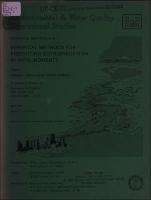Please use this identifier to cite or link to this item:
https://hdl.handle.net/11681/4511Full metadata record
| DC Field | Value | Language |
|---|---|---|
| dc.contributor | Environmental and Water Quality Operational Studies (U.S.) | - |
| dc.contributor.author | Walker, William W. | - |
| dc.date.accessioned | 2016-03-16T22:09:39Z | - |
| dc.date.available | 2016-03-16T22:09:39Z | - |
| dc.date.issued | 1981-05 | - |
| dc.identifier.uri | http://hdl.handle.net/11681/4511 | - |
| dc.description | Technical Report | - |
| dc.description | Abstract: Simple formulations relating nutrient loadings and certain morphologic characteristics to trophic state have provided lake managers one means for describing lake problems and predicting the potential impact of management decisions. While the general utility of such models has been demonstrated for natural lakes, the applicability of models for reservoirs has not received adequate evaluation. Evaluation and the possible modification of existing models for predicting water quality and eutrophication potential is the objective of EWQOS Work Unit IE. This report documents the establishment of a computerized data base containing water quality, hydrologic, and morphometric information for 299 reservoirs operated by the U.S. Army Corps of Engineers (CE). Sources of information included STORET (including the National Eutrophication Survey data), U.S. Department of Agriculture sedimentation survey data sheets, project design memoranda and CE District and Division data files. Supplemental sources included maps, project brouchures, and reports. Programming for data manipulation and analysis is in the PL/I and FORTRAN IV languages. BMDP and SAS programs were employed during preliminary analysis. The data base presently contains over 2.5 million water quality observations taken at 4451 stations located in or around 271 CE reservoirs. Methods for estimating volume and area variations with elevation, required for volume-averaging of water quality data and for calculating material loadings, have been developed. Preliminary analyses have also been performed to assess the importance of spatial and temporal variability to the computation of representative water quality values. Appendix A contains data inventories for each project included in the data base. NOTE: This file is large. Allow your browser several minutes to download the file. | - |
| dc.publisher | Environmental Laboratory (U.S.) | - |
| dc.publisher | Engineer Research and Development Center (U.S.) | - |
| dc.relation | http://acwc.sdp.sirsi.net/client/en_US/search/asset/1040400 | - |
| dc.rights | Approved for public release; distribution is unlimited. | - |
| dc.source | This Digital Resource was created from scans of the Print Resource | - |
| dc.subject | Data bases | - |
| dc.subject | Models | - |
| dc.subject | Eutrophication | - |
| dc.subject | Predictions | - |
| dc.subject | Impoundments | - |
| dc.subject | Reservoirs | - |
| dc.subject | Mathematical models | - |
| dc.subject | Numerical models | - |
| dc.subject | Water quality | - |
| dc.title | Empirical methods for predicting eutrophication in impoundments. Report 1, phase I, Data base development | - |
| dc.type | Report | en_US |
| Appears in Collections: | Technical Report | |
Files in This Item:
| File | Description | Size | Format | |
|---|---|---|---|---|
| TR-E-81-9-Report-1.pdf | 34.26 MB | Adobe PDF |  View/Open |